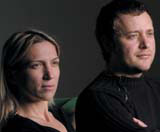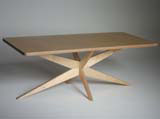Profile: Autoban

Autoban, founded by an interior designer and an architect in Istanbul, produces everything from fashion interiors to quirky furniture that provokes an emotional response, says Trish Lorenz
Seyhan Ozdemir and Sefer Caglar, founders of Istanbul-based design consultancy Autoban, are at the forefront of a very young design scene in Turkey. Istanbul may be their place of work and birth, but they are ambivalent about people labelling their work as Turkish.
‘Istanbul is home to a wide variety of cultures, nationalities and religions, and has been the base of empires since before Christ was born,’ explains Ozdemir. ‘These layers of culture and history are a mystic mixture and, though we don’t obviously reference them, it does influence our work.’
But, she adds, ‘We don’t want to be absorbed by it.’ A depth of history can sometimes act as a constraint, she maintains, and the group is inspired by American designers and their ‘cultural freedom’. ‘Designers in the US aren’t committed to any culture. They’re not bound by anything, they can do whatever they like,’ she says. ‘We see our Turkish identity as purely a base, on to which to add our own style.’
Ozdemir – forthright, passionate and focused – is the energy powerhouse behind the group, while Caglar is calmer and more relaxed. ‘I stress, he sits,’ is how Ozdemir describes the relationship.
‘We’ve been close friends for ten years and we understand each other instinctively. One of us usually comes up with an idea, but we always complete it together – that’s very important. We think and feel very similarly, and if one of us can’t see something, the other can,’ she explains.
They met at art school in Istanbul in 1995. After graduating, they worked separately at local architects and interior design consultancies, until the frustration of ‘thinking differently and feeling differently’ drove them to set up Autoban in April 2003.
The group is based in the chaotic, old town of Istanbul, surrounded by local manufacturers, and overlooking the Galata Tower. Autoban employs six other designers, including one textiles and one graphics specialist.
Initially an interiors and architectural practice, reflecting Caglar and Ozdemir’s background – he is an interior designer, she an architect – the group’s furniture work developed as the group’s founders realised its projects felt incomplete without it.

The group’s interiors work spans retail projects, restaurants and cafés. It has recently completed interiors for Vakko, a Turkish fashion brand that Caglar describes as ‘the Turkish Versace’. It is also working for American retailer V2K, which is in the process of launching its first Istanbul store.
But it’s their furniture that really catches your eye, with its slightly raw, individual style and subtly Turkish aesthetic. The group employs local production techniques, and pieces are made primarily from natural materials, such as wood or metal.
As well as local and classical influences – the Bergere chair, for example, is a ‘flat and sleek’ reinterpretation of a classic – emotional references are evident too. ‘In the process of creating a product, our main design inspiration is the material and its capabilities, but childhood memories and feelings are also important,’ says Ozdemir.
She cites the Starfish, inspired by a childhood visit to a beach, and the Spider Light, one of the group’s first designs, as examples. ‘I like spiders, they’re well formed,’ she says. ‘When you turn the light on you see the shadows of a spider’s leg on the wall. It’s not just the object, it’s how you feel when you see it.’
Caglar believes there is also a search for simplicity and purity in the group’s work. ‘The memories are old school, not modern ones. Memories from a time when things were simpler, when we played with wooden toys, not computer games – a time when objects were pure and basic,’ he says.
But Caglar is also robust on the importance of function. ‘Shape and comfort are vital, especially in seating. Comfort has to be king,’ he explains. Despite its elegant austerity, the Bergere surprises, by being a seat you’ll be reluctant to get up from.
Both Ozdemir and Caglar maintain they are not ambitious, and say they just want to make the things they like. But, when pushed, they name Le Corbusier and Mies van der Rohe as inspirational role models. ‘One day, it’s our dream to be like them – architects with a strong product design background,’ says Ozdemir.
So keep your eye on Turkey – while it may be struggling for broader political acceptance across the EU, its designers are striding boldly into the limelight.
-
Post a comment




